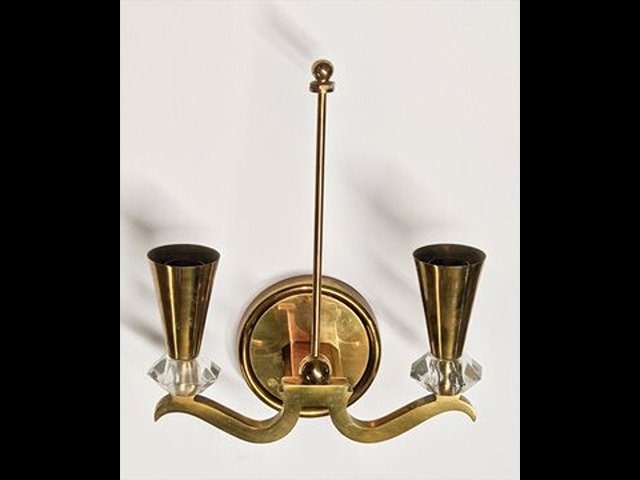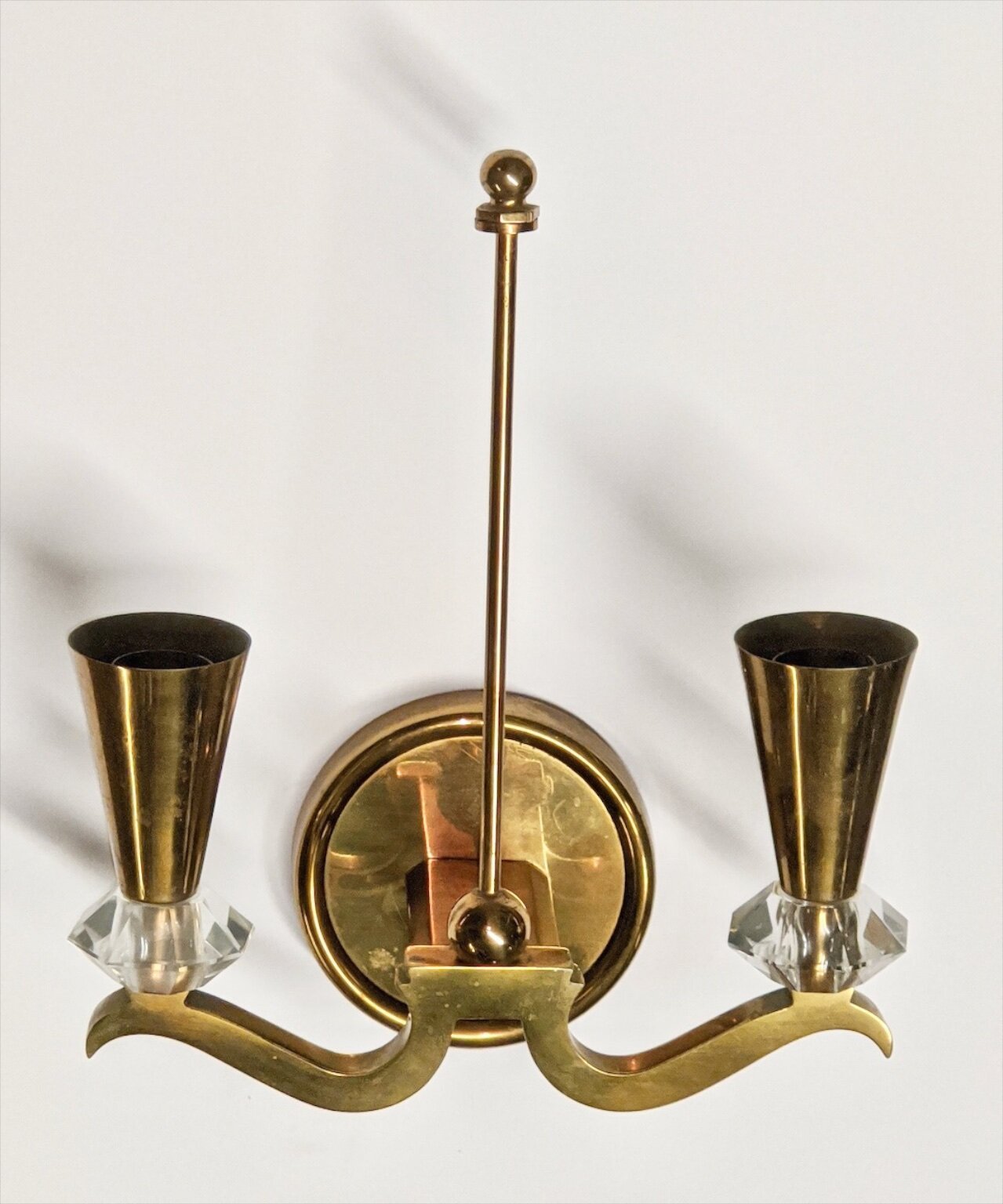Genet et Michon pair of two-branch bronze and crystal sconces (#1619)
French Art Deco pair of bronze and crystal two-branch sconces by Genet et Michon. 10” wide x 5” deep x 10” high.
GENET et MICHON
Philippe Genet and Lucien Michon founded their lighting, furniture and manufacturing company in Paris in 1911. In 1919 they began to specialize in lighting and produced fixtures for the Palais de l’Elysee, Paris and for consulates and ministries. After extensive experiments they discovered that thick pressed glass multiplied reflections and increased the intensity of illumination more than thin glass of other forms. Their highly secret formula, unchanged until 1938, had no pigments added in order not to diminish brightness and glow.
They sometimes etched pressed glass into fixtures and are credited with having introduced the illuminated ramps that bordered a room at the 1925 Paris Exhibition. Also in the 1920s they were pioineers (with Rene Lalique and Jean Perzel) of the suspended illuminated sphere. They deasigned lighting for the grand 1935 oceanliner Normandie, and collaborfated with designers including Jacques-Emile Ruhlmann, Paul Follot, and Maurice Dufrene, and produced numerous small Art Deco furniture pieces.
Their work was shown at the 1922-38 Salons of Societe des Artistes Decorateurs, 1922-24 Salon d’Automn, and others, including 1934, 1935, and the 1937 Paris Exposition Internationale des Arts et Techniques dans la Vie Moderne.
French Art Deco pair of bronze and crystal two-branch sconces by Genet et Michon. 10” wide x 5” deep x 10” high.
GENET et MICHON
Philippe Genet and Lucien Michon founded their lighting, furniture and manufacturing company in Paris in 1911. In 1919 they began to specialize in lighting and produced fixtures for the Palais de l’Elysee, Paris and for consulates and ministries. After extensive experiments they discovered that thick pressed glass multiplied reflections and increased the intensity of illumination more than thin glass of other forms. Their highly secret formula, unchanged until 1938, had no pigments added in order not to diminish brightness and glow.
They sometimes etched pressed glass into fixtures and are credited with having introduced the illuminated ramps that bordered a room at the 1925 Paris Exhibition. Also in the 1920s they were pioineers (with Rene Lalique and Jean Perzel) of the suspended illuminated sphere. They deasigned lighting for the grand 1935 oceanliner Normandie, and collaborfated with designers including Jacques-Emile Ruhlmann, Paul Follot, and Maurice Dufrene, and produced numerous small Art Deco furniture pieces.
Their work was shown at the 1922-38 Salons of Societe des Artistes Decorateurs, 1922-24 Salon d’Automn, and others, including 1934, 1935, and the 1937 Paris Exposition Internationale des Arts et Techniques dans la Vie Moderne.
French Art Deco pair of bronze and crystal two-branch sconces by Genet et Michon. 10” wide x 5” deep x 10” high.
GENET et MICHON
Philippe Genet and Lucien Michon founded their lighting, furniture and manufacturing company in Paris in 1911. In 1919 they began to specialize in lighting and produced fixtures for the Palais de l’Elysee, Paris and for consulates and ministries. After extensive experiments they discovered that thick pressed glass multiplied reflections and increased the intensity of illumination more than thin glass of other forms. Their highly secret formula, unchanged until 1938, had no pigments added in order not to diminish brightness and glow.
They sometimes etched pressed glass into fixtures and are credited with having introduced the illuminated ramps that bordered a room at the 1925 Paris Exhibition. Also in the 1920s they were pioineers (with Rene Lalique and Jean Perzel) of the suspended illuminated sphere. They deasigned lighting for the grand 1935 oceanliner Normandie, and collaborfated with designers including Jacques-Emile Ruhlmann, Paul Follot, and Maurice Dufrene, and produced numerous small Art Deco furniture pieces.
Their work was shown at the 1922-38 Salons of Societe des Artistes Decorateurs, 1922-24 Salon d’Automn, and others, including 1934, 1935, and the 1937 Paris Exposition Internationale des Arts et Techniques dans la Vie Moderne.


